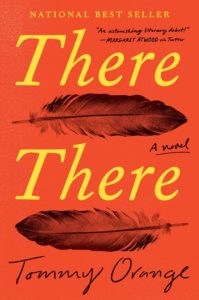 There There by Tommy Orange
There There by Tommy Orange Published by Knopf on June 5, 2018
Genres: Contemporary Fiction
Pages: 294
Format: Hardcover
Buy on Amazon
Goodreads

Fierce, angry, funny, heartbreaking—Tommy Orange’s first novel is a wondrous and shattering portrait of an America few of us have ever seen, and it introduces a brilliant new author at the start of a major career.
There There is a relentlessly paced multigenerational story about violence and recovery, memory and identity, and the beauty and despair woven into the history of a nation and its people. It tells the story of twelve characters, each of whom have private reasons for traveling to the Big Oakland Powwow. Jacquie Red Feather is newly sober and trying to make it back to the family she left behind in shame. Dene Oxendene is pulling his life back together after his uncle’s death and has come to work at the powwow to honor his uncle’s memory. Opal Viola Victoria Bear Shield has come to watch her nephew Orvil, who has taught himself traditional Indian dance through YouTube videos and has come to the powwow to dance in public for the very first time. There will be glorious communion, and a spectacle of sacred tradition and pageantry. And there will be sacrifice, and heroism, and unspeakable loss.
Here is a voice we have never heard—a voice full of poetry and rage, exploding onto the page with stunning urgency and force. Tommy Orange writes of the urban Native American, the Native American in the city, in a stunning novel that grapples with a complex and painful history, with an inheritance of beauty and profound spirituality, and with a plague of addiction, abuse, and suicide. An unforgettable debut, destined to become required reading in schools and universities across the country.
This book is a stunner. I checked into it after hearing so many teacher friends talking about it on Twitter, and I’m so glad I did. I plan to incorporate it into my curriculum for a new Social Justice in Literature and History course I will be proposing.
Not only is the language masterful, but Tommy Orange created memorable characters, connected in some ways to other characters. All their paths will converge at the Big Oakland Powwow. I haven’t quite read anything like it from a Native American writer, in part because Orange focuses on the “urban Indian.” I learned quite a few things I didn’t know from this book as well. For example, I had no idea Native Americans “occupied” Alcatraz in the late 1960s and early 1970s.
The book raises many issues worthy of discussion, from the treatment of Native Americans in the United States, to spousal abuse, to child neglect, to Fetal Alcohol Syndrome, to the importance of storytelling, to recapturing lost culture, to OCD. Yet, it never feels like a novel stacking as many issues as society confronts as it can all at once. It just feels like it’s telling it like it is.
By the end, I was invested in the characters and hoped they might each find some closure. It’s a beautiful, poignant novel, and if I hadn’t read Homegoing this year, it would run away with the title of the best book of the year for me. As it is, it’s a tough call. I might have to have two favorites.
I am calling it a wrap on the Monthly Motif Challenge for 2018 and electing to classify this as a repeat of the “Diversify Your Reading” theme from January. I never did a Vacation Read in July. Perhaps I’ll try to squeeze that last book in during my winter break.